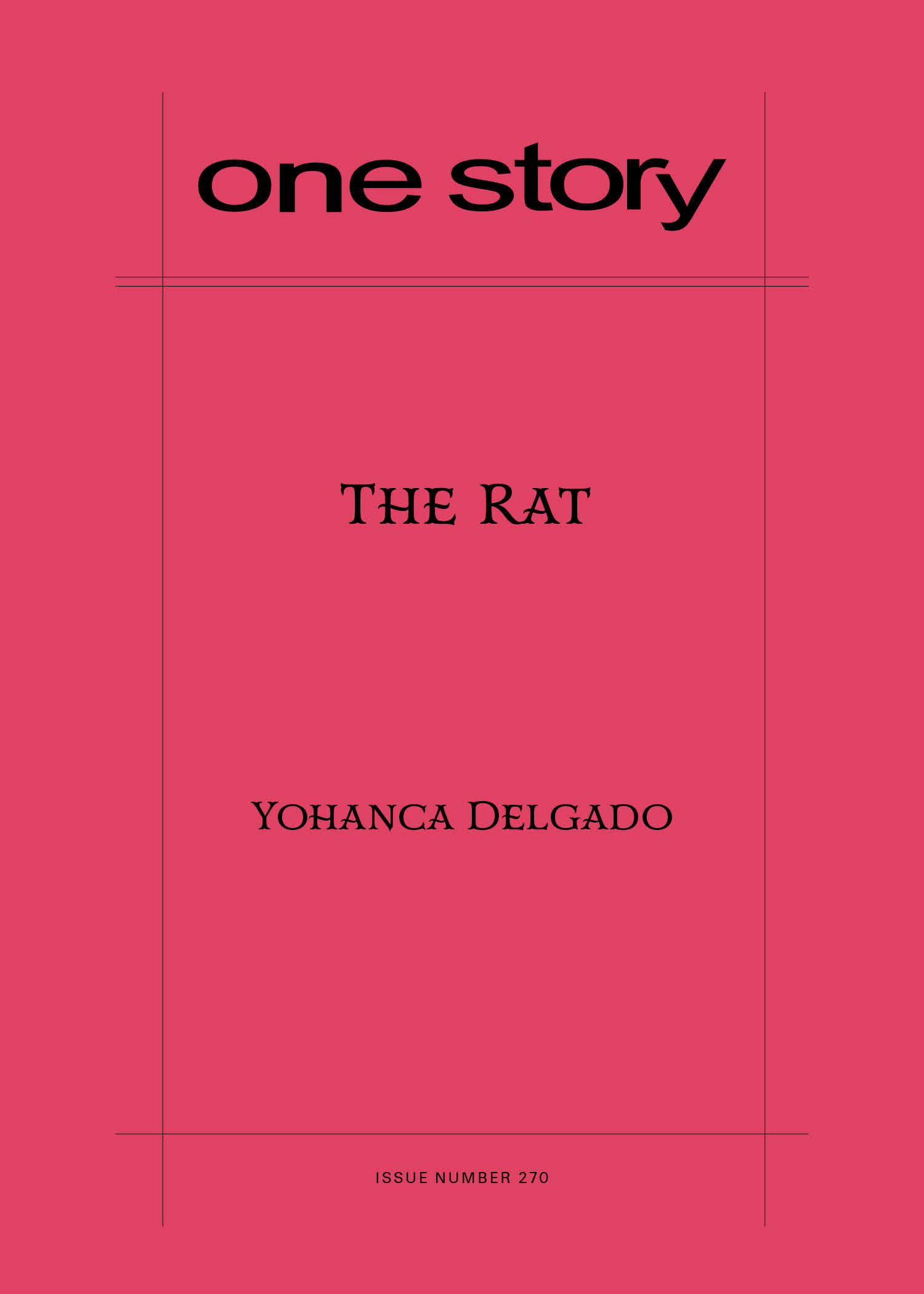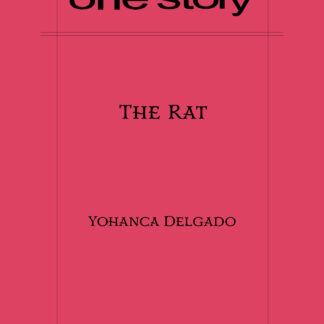
The Rat
$2.50
40 in stock
Excerpt
For New York at 6:48 in the evening, this building is strangely quiet. The one working light in the hallway flickers every ten seconds across the goosebump layers of glossy beige paint on the walls. I ring the bell again and let my finger drop as a weak chime echoes feebly, then dies somewhere beyond the door. A distant thud tells me to wait a few moments longer, and I look down at my scuffed sneakers against the black and white tiled floor. I’m hot in my ridiculous corn-yellow blazer and my shoulder slouches from the weight of my Kutco-issued messenger bag. Is it just me, or does this hallway smell like trash?
I place my forehead against the wall and let my mind wander to where it always goes, to my mother. I’m sitting on a dresser in her bedroom in Flushing, legs hanging over the edge. She’s wearing a black dress with a swishy skirt and heels. She’s leaning over me, painting my lips with the careful, whiskery strokes of a lip brush. Her perfume envelops me, that lace of roses, honey, and tobacco that smells different on my skin, no matter how many times I spray it.
Here, in this dark hallway, I sniff my wrist and let it drop. I’ll never smell her again.
Yohanca Delgado
Yohanca Delgado was born and raised in New York City and holds an MFA from American University. Her work has appeared or is forthcoming in STORY, A Public Space, and The Believer. She is writing a collection of short stories and a novel. You can find her online at @yodelnyc.
Lena Valencia on “The Rat”
When outdoor dining opened in New York City in late June, there was a news item making the rounds: Rats, deprived of their usual diet of pizza and bagels during the city’s lockdown, were harassing al fresco diners. Though the idea of a rat scuttling into my $19 grain bowl is horrifying, there was something about the resilience of these creatures that I found amusing, even, dare I say it, inspiring. It was also a reminder that NYC was back, or, rather, had never left: there is no New York City without its vermin, after all.
In “The Rat,” Yohanca Delgado uses the unofficial mascot of NYC to represent a different sort of resilience. Samanta, a down-on-her-luck door-to-door knife saleswoman, is struggling with the loss of her late mother when she meets an eccentric stranger who not only offers to buy enough knives to vault Samanta out of her financial troubles but claims that she can rid her of her grief. If this sounds too good to be true, it is, and this is what Samanta discovers soon after she consents to the stranger’s proposal and finds herself being followed by a rat.
It’s appropriate that this story is coming out around Halloween, a time when many of us revisit our favorite horror films and books. Delgado is an expert at creating unsettling spaces and making the reader squirm with discomfort. And, like the very best horror stories, “The Rat” isn’t just about a monster—in this case a seemingly immortal rat; it’s about embracing those tough, painful feelings that are so tempting to ignore or push away. Much like the persistent rat of this story’s title, they won’t just vanish. They’re a part of you. As Delgado states so aptly in her interview, “nothing evaporates into thin air, nothing disappears forever.” We’re thrilled to share “The Rat” with you.
Q&A by Lena Valencia
- LV: Where did the idea for this story come from?
- YD: This story began as several ideas in a trenchcoat. In 2018, I heard the wonderful poet and novelist Elizabeth Acevedo talk about writing a poem about rats, because that’s the animal she saw the most when she was growing up in New York. I loved that! She’s right, rats are the iconic New York fauna. I resolved to write a story about a rat, but I hadn’t found the right narrative yet. In high school, I spent a miserable summer trying, unsuccessfully, to sell knives. The knives themselves were excellent, but I was a horrible salesperson. Of course, the whole thing was redolent of a pyramid scheme (why else would you hire high schoolers to peddle knives?) and my parents had to lend me the money to buy a demonstration set, which wasn’t cheap. My failed knife sales career is a long-running joke, but my family uses those demo knives to this day. I wanted to write a story that explored that door-to-door sales dynamic, the awkward tension of sitting in some stranger’s house, unpacking your wares and trying to say what they want to hear. I’d written several drafts and scenes exploring this idea but hadn’t found my spark yet. I also wanted to write about wish fulfillment. I’d just finished my MFA, and one of my mentors, Dolen Perkins-Valdez, looked at one of my stories and asked, “But what if she gets what she wants? What then?” I wanted to write a new story that wrestled with that question.
- LV: What was the most challenging aspect of writing this story?
- YD: I tried to write it in a week! I was at the Clarion Workshop in San Diego. At Clarion, you submit a story a week for six weeks and workshop with a new instructor each time. I was convinced that I couldn’t write this story, that I wasn’t ready to write it yet. But I also felt like I couldn’t write anything else; the idea was clouding everything else out. I skipped my turn, and spent that time beating myself up for it. Then I met with Andy Duncan, our faculty instructor that week, and he expressed such unwavering faith in my writing. He let me talk through the plot and asked me some sharp questions that helped me define my intentions for the story. It was like literary therapy. Such kindness. I ran back to my room and started typing. Of course, that was only the beginning of my journey with “The Rat.” Ann and Jeff VanderMeer led the workshop of it the following week, and, with my classmates and Shelley Streeby, gave me such brilliant, actionable feedback. I revised it and showed it to my writing group in DC that fall, and they also had marvelous insights. And then I entered into the revision process with you and Patrick here at One Story. It is such a gift to be read so closely and edited so generously, thank you. That process really snapped the story into focus for me. All said, I think the story took a full six months to conceive and complete, even though I had been carrying the ideas around for years.
- LV: There are so many creepy images in this story: Samanta unspooling and crushing lipstick, the procedure Consuela performs at the kitchen table, and, of course, the rat herself. They left me feeling unmoored in the way that the best horror does. What were some of your influences for “The Rat”
- YD: Thank you! The unspooling of lipstick actually emerged during the editing process with you and Patrick. I sat down to revise and it just tumbled out on the page, like a memory. Well, it is a memory, because I definitely got into my mother’s lipsticks as a toddler and had a good time crushing and eating them. The shouting and scrubbing that ensued was also memorable. My in-laws have a cuckoo clock, and whenever I visit, I stare at it. Maybe it’s because it’s the first one I’ve seen in someone’s home, but I find it very charming. There’s something pleasantly strange about a fake little bird popping out of its fake little house to announce the time. As far as literary influences go, I love a good sales story. Two of my favorites are Jorge Luis Borges’ “The Book of Sand” and Steven Millhauser’s “Miracle Polish.” As I mentioned earlier, there’s something about that salesy dynamic that I find really juicy and interesting. But I wondered, what if both the salesperson and the customer were “selling” something? I also love Elizabeth Bishop’s poem “The Fish.” That veneration the speaker feels towards the fish sparked one of the central questions of this story: what if you could really see the depths of your own grief — and treasure it for what it is, a record of all you have loved and survived in this life?
- LV: I loved the way this story used supernatural elements to explore grief. Can you talk a little bit about writing the supernatural, and the constraints and freedoms that come with it?
- YD: When I start a story, I have no idea where it will land on the spectrum between mimetic and speculative fiction. In this case, I wanted to defamiliarize grief and put it at arm’s length so that I could see it better. For me, putting a story into a magical or speculative space is like taking away gravity. A playful freedom comes from that; anything is possible! But as the writer, I think you have to then put down stakes to keep the whole world from floating away. You have to find new logic to anchor the story in the mind. In this story, there are magical elements, but they are limited in scope. Nothing evaporates into thin air, nothing disappears forever.
- LV: You’re from New York City, where this story is set. What’s it like to write about your home when your home is a place that so many others (native or otherwise) have written about?
- YD: I used to worry about writing about New York! Hasn’t every New York story been told before? Are people sick of reading about New York? But it’s such a vast and varied place. The boroughs and the neighborhoods are all culturally different from each other, and they’re changing all the time. Every single person has their own New York. I think it’s like grief in that way. I’ve been letting myself gravitate to New York in my writing. I don’t live there anymore, and though I visit my family fairly often, I haven’t lived there in a long time. I think that distance makes me feel as if I can see it better. More importantly, I want to see it better, because that’s where all my formative memories live.
- LV: What are you working on now?
- YD: I say I’m working on a novel. I tell everyone, even people who don’t ask. I’m essentially wearing a sandwich-board proclaiming my novelistic intentions. But the honest truth is that it’s really hard to write anything these days. I’m seizing joy where I can find it. For me, nothing beats the thrill of a weird short story.
- LV: What is the best bit of advice about writing you have ever received?
- YD: My first MFA instructor was the inimitable Richard McCann, who at the time was teaching nonfiction. Very early in the semester, he leaned across the workshop table and said to us, “Don’t write from anger, write from grief.” I think about that all the time, regardless of what genre I’m writing in or what I’m writing about. Tearing something down is always going to be the cheap, easy way out. Finding the sadness means looking at what you wish you didn’t have to see and writing into what makes you uncomfortable. I think it’s also an inherently generous place to write from. It allows space for humor and nuance in a way that anger does not.
